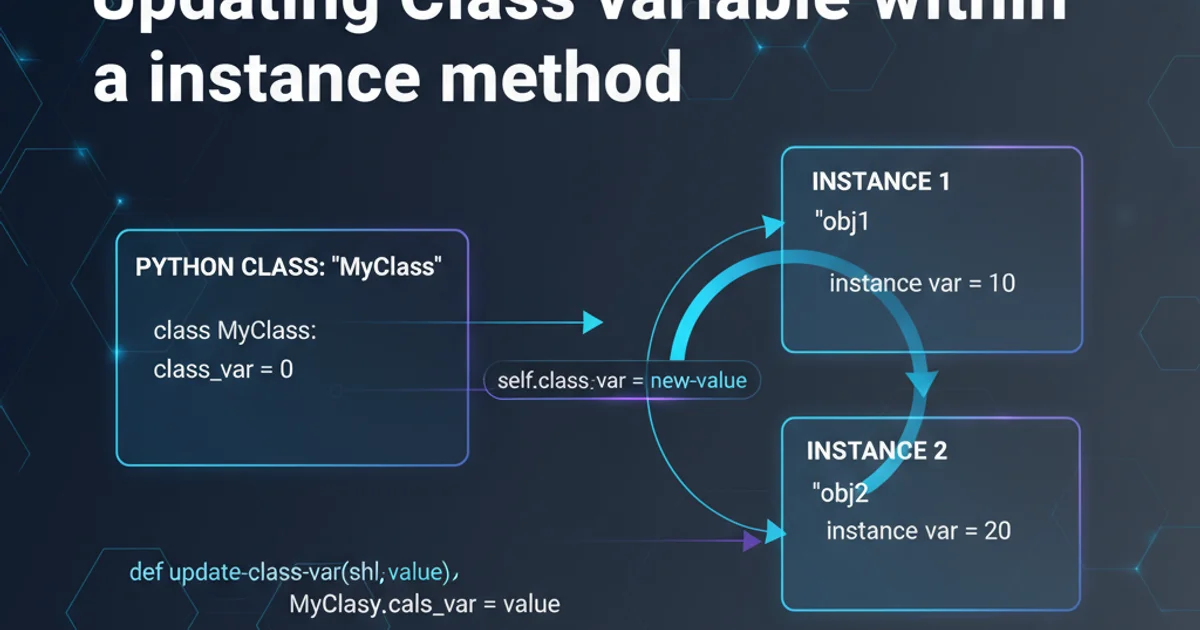Updating Class variable within a instance method
Categories:
Updating Class Variables from Instance Methods in Python

Explore the nuances of modifying class-level variables from within instance methods in Python, understanding scope and best practices.
In Python, understanding the distinction between class variables and instance variables is fundamental. Class variables are shared among all instances of a class, while instance variables are unique to each instance. A common point of confusion arises when attempting to modify a class variable from an instance method. This article delves into how Python handles such operations, the potential pitfalls, and the recommended approaches to ensure predictable and maintainable code.
Understanding Class and Instance Variable Scope
Before attempting to modify a class variable, it's crucial to grasp how Python resolves variable names. When you access an attribute using self.attribute_name within an instance method, Python first looks for attribute_name in the instance's dictionary (self.__dict__). If it doesn't find it there, it then searches the class's dictionary (ClassName.__dict__) and its base classes. This lookup order is key to understanding modification behavior.
flowchart TD
A[Access `self.var_name`]
A --> B{Is `var_name` in `self.__dict__`?}
B -->|Yes| C[Use `self.__dict__['var_name']` (Instance Variable)]
B -->|No| D{Is `var_name` in `Class.__dict__`?}
D -->|Yes| E[Use `Class.__dict__['var_name']` (Class Variable)]
D -->|No| F[AttributeError]Python Attribute Lookup Order for self.attribute_name
Modifying Class Variables Directly
To explicitly modify a class variable from an instance method, you must reference it using the class name itself, not self. If you use self.class_variable = new_value, Python will create a new instance variable with that name, effectively 'shadowing' the class variable for that specific instance, rather than updating the class variable for all instances.
class MyClass:
class_var = 0 # This is a class variable
def __init__(self, instance_id):
self.instance_id = instance_id
def increment_class_var_incorrectly(self):
# This creates an instance variable 'class_var' for 'self'
# It does NOT modify MyClass.class_var
self.class_var = self.class_var + 1
print(f"Instance {self.instance_id} (self.class_var): {self.class_var}")
print(f"Class (MyClass.class_var): {MyClass.class_var}")
def increment_class_var_correctly(self):
# This correctly modifies the class variable
MyClass.class_var += 1
print(f"Instance {self.instance_id} (self.class_var): {self.class_var}")
print(f"Class (MyClass.class_var): {MyClass.class_var}")
# Demonstrate incorrect modification
print("--- Incorrect Modification ---")
obj1 = MyClass("A")
obj2 = MyClass("B")
obj1.increment_class_var_incorrectly() # obj1.class_var becomes 1, MyClass.class_var remains 0
obj2.increment_class_var_incorrectly() # obj2.class_var becomes 1, MyClass.class_var remains 0
print(f"After incorrect: obj1.class_var = {obj1.class_var}, obj2.class_var = {obj2.class_var}, MyClass.class_var = {MyClass.class_var}")
# Reset for correct demonstration
MyClass.class_var = 0
print("\n--- Correct Modification ---")
obj3 = MyClass("C")
obj4 = MyClass("D")
obj3.increment_class_var_correctly() # MyClass.class_var becomes 1
obj4.increment_class_var_correctly() # MyClass.class_var becomes 2
print(f"After correct: obj3.class_var = {obj3.class_var}, obj4.class_var = {obj4.class_var}, MyClass.class_var = {MyClass.class_var}")
Demonstrating correct and incorrect ways to update a class variable.
self.class_list.append(), you are modifying the class variable because self.class_list resolves to the class's list. However, if you reassign self.class_list = new_list, you create an instance variable.When to Use Class Methods for Class Variable Updates
For clearer intent and better encapsulation, it's often preferable to update class variables using a @classmethod. A class method receives the class itself (conventionally named cls) as its first argument, making it explicit that you are operating on the class rather than a specific instance. This approach enhances readability and prevents accidental shadowing.
class Counter:
count = 0 # Class variable
def __init__(self, name):
self.name = name
@classmethod
def increment_counter(cls):
cls.count += 1
print(f"Counter.count is now: {cls.count}")
def do_something(self):
print(f"Instance '{self.name}' is doing something.")
# An instance method can call a class method to update the class variable
Counter.increment_counter() # Or self.increment_counter() - both work here
# Using the class method directly
print("--- Using Class Method Directly ---")
Counter.increment_counter()
Counter.increment_counter()
# Using the class method via an instance
print("\n--- Using Class Method via Instance ---")
obj_a = Counter("Alpha")
obj_b = Counter("Beta")
obj_a.do_something() # This calls Counter.increment_counter()
obj_b.do_something() # This calls Counter.increment_counter()
print(f"Final Counter.count: {Counter.count}")
Updating a class variable using a @classmethod.
classDiagram
class MyClass {
+class_var: int
+instance_id: str
+increment_class_var_incorrectly()
+increment_class_var_correctly()
}
class Counter {
+count: int
+name: str
+increment_counter(cls)
+do_something()
}
MyClass "1" -- "*" MyClassInstance : has
Counter "1" -- "*" CounterInstance : has
MyClassInstance ..> MyClass : accesses class_var
CounterInstance ..> Counter : calls classmethodClass diagram illustrating class and instance relationships with variable access.
__init__.